|
|
|
Sort Order |
|
|
|
Items / Page
|
|
|
|
|
|
|
| Srl | Item |
| 1 |
ID:
086714
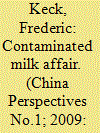

|
|
|
|
|
| Publication |
2009.
|
| Summary/Abstract |
The scandal following the revelation of the use in melamine, which causes acute kidney problems, in the production of milk powder created one of the greatest heath crises in contemporaty China. Since the SARS epidemic in 2003, the chinese government has been particularly keen to deal with such questions in the field of public health.
|
|
|
|
|
|
|
|
|
|
|
|
|
|
|
|
| 2 |
ID:
086165


|
|
|
|
|
| Publication |
2009.
|
| Summary/Abstract |
The epidemic of piracy off the coast of Somalia since 2007 included the spectacular pirating in November 2008 of the Saudi supertanker Sirius Star containing a quarter of Saudi Arabia's daily oil production; the ship was released on 10 January 2009 in exchange for a $3 million ransom. The epidemic has led to extensive media commentary, a flurry of UN Security Council resolutions, and deployment of an unusual combination of some of the world's most powerful navies to escort commercial ships through one of the world's busiest, and now most dangerous, shipping lanes.
Predictably, policymakers, pundits and politicians have sought to harness the piracy story to advance their own agendas. Many have seized on it to plead for a durable political solution to the 19-year crisis of state collapse in Somalia. This is a waterborne variation on the 'securitisation' of state-building, the argument that failed states pose a host of spillover dangers, including piracy, if left unresolved. Humanitarians have contrasted the robust international anti-piracy response with the tepid global mobilisation to address Somalia's horrific humanitarian crisis, in which three million Somalis are in need of emergency aid. Some apologists have cast Somali piracy in 'Robin Hood' terms, as a legitimate local response by poor coastal fishing communities against external predators engaged in illegal fishing and toxic-waste dumping in their waters. More than a few journalists have framed the Somali piracy story as another example of 'Mad Max anarchy' prevailing in the hopelessly ungovernable place called Somalia. Still others warn that it is only a matter of time before the pirates fire on a ship laden with chemicals or fuel, producing an environmental disaster on Somalia's shoreline. And counter-terrorism experts have expressed concern over a 'terrorism-piracy nexus' in which some of the tens of millions of dollars of ransom money flowing into Somalia are being garnered by the al-Qaeda affiliate in Somalia known as al-Shabaab. What all of these perspectives share is the claim that Somali piracy is only a symptom of a much bigger political problem on land.
|
|
|
|
|
|
|
|
|
|
|
|
|
|
|
|
| 3 |
ID:
117630
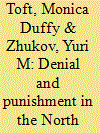

|
|
|
|
|
| Publication |
2012.
|
| Summary/Abstract |
A growing literature on the subnational diffusion of armed conflict rests on the proposition that political violence triggers more violence, in the same locality and elsewhere. Yet state efforts to contain such uprisings remain largely unexplored, theoretically and empirically. Drawing on a mathematical model of epidemics, we formalize the logic of conflict diffusion and derive conditions under which state coercion might limit the spread of insurgent violence. Using a new dataset of insurgent and government violence in Russia's North Caucasus from 2000 to 2008, we evaluate the relative effectiveness of four coercive strategies: (1) denial, which manipulates the costs of expanding insurgent activity to new locations, (2) punishment, which manipulates the costs of sustained fighting in contested areas, (3) denial and punishment, which does both, and (4) no action, which does neither. We find denial to be most effective at containing insurgent violence. Punishment is least effective, and even counterproductive. Not only does such a strategy fail to prevent the spillover of violence to new locations, but it may amplify the risk of continued fighting in contested areas. In the Caucasus, denial is found to be the least inflammatory counter-insurgency option for Russia. For it to succeed, Russia should physically isolate centers of insurgent activity from regions of nonviolence and avoid the temptation of punitive reprisals.
|
|
|
|
|
|
|
|
|
|
|
|
|
|
|
|
| 4 |
ID:
086706
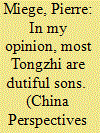

|
|
|
|
|
| Publication |
2009.
|
| Summary/Abstract |
Based on interviews with young homosexuals in Hefei, Anhui Province, this article examines the precarious modes of socialisation of young tongzhi(a term often used by gay people to refer to themselves), centred on the Internet and small groups of friends. The difficulty they have in constructing an identity based on sexuality stands out in the context of social norms and roles they cannot resolve to defy, above all because of their feelings of respect and duty towards their parents.
|
|
|
|
|
|
|
|
|
|
|
|
|
|
|
|
| 5 |
ID:
175936
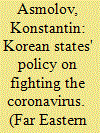

|
|
|
|
|
| Summary/Abstract |
Against the background of a protracted and arduous war on the coronavirus pandemic, the experience of countries that were able either to keep the virus out or to handle the problem with relatively few cases and deaths draws attention. In this context, both the DPRK and RoK are interesting examples, whose experiences, including comparative ones, are worth a more careful look. In both countries, the control of coronavirus has proven to be a political issue, and therefore these states have invested as much as possible in solving the problem, using all means of control according to the available technological level.
|
|
|
|
|
|
|
|
|
|
|
|
|
|
|
|
| 6 |
ID:
153099
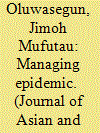

|
|
|
|
|
| Summary/Abstract |
This paper examines how the British managed the 1918–1919 influenza epidemic in Lagos, the reactions of the local population to new sanitary and medical policies enforced during the period, and its social and political implications for future epidemic management in the colony. Unlike several studies which approach the history of the pandemic from global and national perspectives, a focus on Lagos, the colonial capital of Nigeria, one of Britain’s most important colonies provides this paper with a rare opportunity to engage with how local peculiarities informed decisions about the resolution of a global problem. Lagos is chosen as the terrain for discussion because of the ample data generated about it in the course of the 19th and 20th centuries (not just between European missionaries and the indigenous Lagosians, but also for other influential cultural and ethnic groups such as the Saro and Amaro (migrants from Brazil), and the Indian influence on medical policies in Lagos).
|
|
|
|
|
|
|
|
|
|
|
|
|
|
|
|
| 7 |
ID:
103649
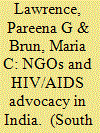

|
|
|
|
|
| Publication |
2011.
|
| Summary/Abstract |
India has the second-largest population living with HIV/AIDS in the world. Although the exact number of HIV positive people is contested, it is predicted that the current numbers are likely to grow at a rapid rate in the next decade if the epidemic goes unchecked. This paper explores the HIV/AIDS epidemic in India through the perspective of two non-governmental organisations (NGOs) whose roles have become critical in the fight against the disease. Specifically, it identifies the challenges faced by these NGOs such as lack of government responsiveness, funding-related problems, corruption, donor accountability, and cultural attitudes to HIV/AIDS, while exploring the theoretical implications of NGOs playing a greater role in providing programming and services to those living with, and affected by, the epidemic.
|
|
|
|
|
|
|
|
|
|
|
|
|
|
|
|
| 8 |
ID:
187853


|
|
|
|
|
| Summary/Abstract |
While charitable donations help to raise funds and contribute to pandemic prevention and control, there are many unanswered questions about how people make such donation decisions, especially in countries like China where charitable donations have played an increasing role in recent years. This study contributes to the literature by assessing the potential impacts of Chinese netizens' experience with the 2002 severe acute respiratory syndrome (SARS) epidemic on their willingness to donate for COVID-19 pandemic prevention and control. Specifically, this study applies a difference-in-differences (DID) model to a dataset collected from a nationwide survey to examine how individuals' exposure to the SARS epidemic affects their willingness to donate to alleviate the COVID-19 pandemic. The results suggest that individuals' SARS epidemic experiences in their early lives, especially during the “childhood-adolescence” period, had a lasting and far-reaching impact on their willingness to donate toward COVID-19 pandemic prevention and control. Also, the impacts were likely heterogeneous by such sociodemographic factors as educational background, health status, and income level. The empirical findings highlight the importance of considering early-life experiences in developing and implementing epidemic prevention and control policies. While the SARS experience likely affected Chinese netizens' willingness to donate toward COVID-19 pandemic prevention and control, lessons learned from both the SARS epidemic and COVID-19 pandemic could be used to develop more effective public health education and prevention programs as well as to increase public donations for future pandemic prevention and control.
|
|
|
|
|
|
|
|
|
|
|
|
|
|
|
|
| 9 |
ID:
086702
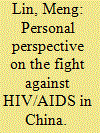

|
|
|
|
|
| Publication |
2009.
|
| Summary/Abstract |
In this testimony, Meng Lin, a person living with HIV/AIDS (PLWHA) in China and at the same time an activist engaged in the fight against the epidemic, shares his insight into the current situation from both a personal and professional perspective. In the latter case, he speaks in his capacity as founder of Ark of Love, an association that aims to inform and help PLWHA to organise themselves and set up their own structures for mutual aid and defence of their rights.
|
|
|
|
|
|
|
|
|
|
|
|
|
|
|
|
| 10 |
ID:
175106


|
|
|
|
|
| Summary/Abstract |
The 1918–19 influenza epidemic arguably remains the worst natural disaster in the annals of colonial India. The scourge of the 1918–19 influenza in Punjab eclipsed the significant malaria epidemics of 1908 and the Bubonic plague catastrophe of the first decade of the 20th century. Over 800,000 people died from the outbreak between October and November 1918. This article examines the social and economic impacts of the 1918–19 influenza outbreak in Punjab. It argues that the scarcity of everyday food items as well as an escalation in the prices of staple foodstuffs were direct consequences of the epidemic. This study discovered that massive influenza mortalities triggered severe disruptions in the agricultural activities and public services in Punjab. Other studies had focused mainly on the spread and mortality of the epidemic in the public domains of colonial India. However, this study illuminates the socio-economic effects of an outbreak from a regional perspective. A focus on Punjab, the colonial capital of Northern India, affords us a rare privilege to gauge how epidemics influence the socio-economic spaces on a provincial basis.
|
|
|
|
|
|
|
|
|
|
|
|
|
|
|
|
| 11 |
ID:
129283


|
|
|
|
|
| Publication |
2012.
|
| Summary/Abstract |
The article presents a speech by Chinese President Hu Jintao, delivered at the General Meeting in China on December 20, 2009, in which he discussed the celebration of the 10th anniversary of the return of Macau, China to the country, financial crisis, and the severe acute respiratory syndrome (SARS) epidemic.
|
|
|
|
|
|
|
|
|
|
|
|
|
|
|
|
| 12 |
ID:
086704
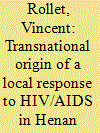

|
|
|
|
|
| Publication |
2009.
|
| Summary/Abstract |
For several years now, at a time when Henan remains one of the areas of China most heavily affected by the HIV/AIDS virus, peasants in several of the worst affected villages have supplemented the official policies and strategic approaches to deal with its spread by progressively mobilising and organising their own local measures to deal with the social challenges that AIDS imposes on rural communities. This article is particularly concerned with the transnational origin behind this local mobilisation.
|
|
|
|
|
|
|
|
|
|
|
|
|
|
|
|
|
|
|
|
|